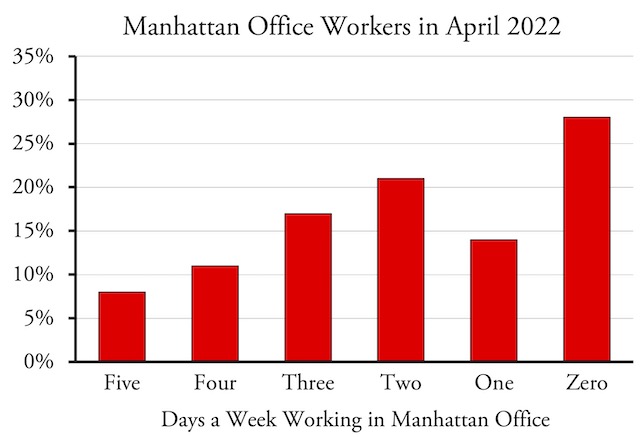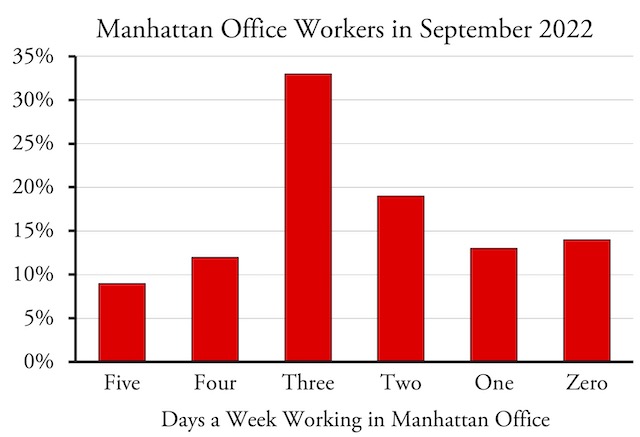As of the end of April, 72 percent of Manhattan office workers were back at work in their offices. Most, however, were working there only three days a week or less. On any given weekday, only 38 percent of offices were occupied, according to a survey released by the Partnership for New York City. Of the ones who have returned to their offices, more are working there just two days a week than any other schedule.
Currently, working at home full-time is most common among former Manhattan office workers, followed by working in the office two days a week.
The Partnership survey also asked how employers expect people to be working in September. By that time, about a third expect to work in offices three days a week, but 14 percent still expect to work at home full time. On any given weekday, slightly less than half of offices will be occupied.
By September, working in an office three days a week is expected to be most common, but on any given weekday less than half of former office employees are likely to work in their offices.
Prior to the pandemic, the survey found, 84 percent of employers required workers to come to their offices five days a week, and only 7 percent allowed a hybrid model or full-time working at home. Currently, 78 percent expect to operate under a hybrid model after the pandemic and up to 13 percent will allow employees to work at home full time.
It is likely that similar numbers apply in other downtowns, which provides further evidence that transit ridership will never recover to pre-pandemic levels. High-income downtown office workers had been transit’s only real growth market prior to the pandemic. Now it appears that transit will permanently lose most of those riders.










What changed for business was Satellite offices.
BIG corporate buildings are obsolete…..Unlike manufacturing there’s little need to consolidate 1000 workers in one location. 10 SMALL buildings dotted across the town is more prevalent. Think of all the businesses and institutions that use satellite installations…
– police stations
-fire houses
-military bases
– banks
-storage warehouses
The skyscraper has been rendered obsolete. One of America’s most famous architects Frank Lloyd Wright….never designed a high rise building in his life except one 19 story building in Oklahoma. Wright thought little of down downtowns… not much of an urbanist. Even in his day In the days of electrical transmission, the automobile and the telephone,” he wrote in 1922, a dense downtown “becomes needless…
Of course for sanity sake human direct organic communication is essential. But we need not occupy canyons of concrete and glass.
Downtowns are getting more and more empty and unpopular…. tech companies pioneered campus style work accommodations. History of white Collar labor occupied five paradigm shifts…..
– the factory/office vertical integration with horizontal layouts.
– midrise office and downtown complex.
– skyscrapers
– suburban office park and the birth if the cubicle farm
– campus style layout
LR,
In addition to Price Tower, F.L. Wright also built the SC Johnson Tower.
That said, your point on the future of downtowns stands. While it shouldn’t have taken this long for corporate management to recognize the benefits, remote work has been a financial boom to companies whose primary focus is data/info processing and transfer.
Outside of the sports arena, museum or art gallery, everything located in the city center can be replicated on a smaller scale in the suburbs.
FLW also designed the Mile-High Illinois, which would be the tallest building in the world if it had been built. But some say he did so as a joke. In the 1920s, he scornfully referred to advocates of tall buildings as “skyscraperites” and said that such buildings had been rendered obsolete by electricity, the telephone, and the motor car.
Johnson wax buildings tower is 6 stories…thats not a skyscraper even by 1930s standard…
Below 3-4 stories is a low-rise
5-15 stories is a Midrise
Any building above that is a highrise…..
1000 feet is a Supertall.